Lava Xolo X900 Review - The First Intel Medfield Phone
by Brian Klug on April 25, 2012 6:00 AM ESTBattery Life
Nailing performance is one thing, but in order to really sell Medfield and other upcoming SoCs to OEMs, Intel has to deliver battery life and power consumption that's competitive. It's about performance/power in the SoC space. First, it's worthwhile to note that the X900 includes a relatively small battery, at just 5.4 Whr. Of late, batteries over 6 Whr seems like the norm, and I'm told that future designs including the Motorola phone will probably include larger ones. It's just good to have that frame of reference and this chart should help:
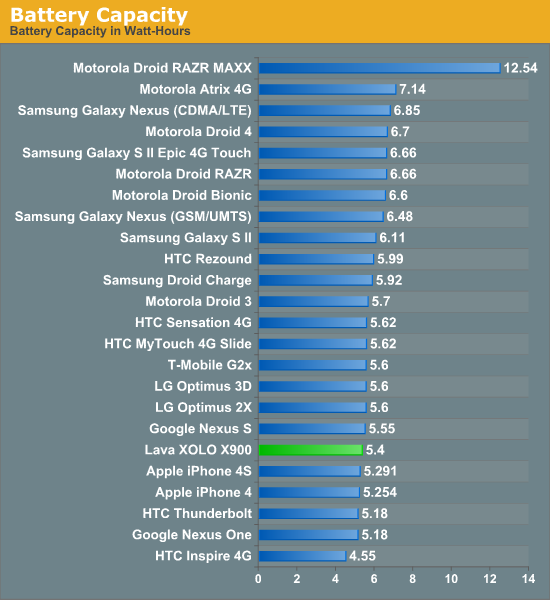
Intel notes battery life in their own X900 announcement blast as being around 5 hours of continuous 3G browsing and 8 hours of talk time. Our own numbers end up being pretty darn close, at 4.6 hours and 8.5 hours for those two metrics, respectively.
As a reminder, the browsing tests happen at 200 nits and consist of a few dozen pages loaded endlessly over WCDMA or WiFi (depending on the test) until the phone powers off. The WiFi hotspot tethering test consists of a single attached client streaming 128 kbps MP3 audio and loading four tabs of the page loading test through the handset over WCDMA with the display off.
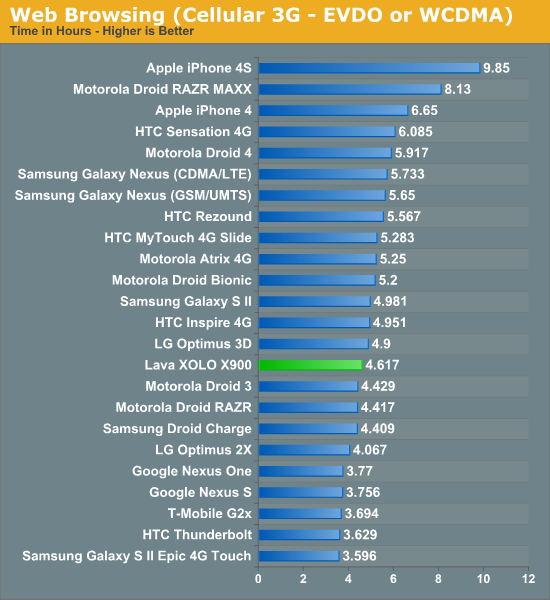
As a smartphone the X900 does a bit below average here, but as we mentioned it also has an unusually small battery for a modern flagship Android smartphone. If we divide battery life by battery capacity, we can get a better idea for how the Medfield platform compares to the competition:
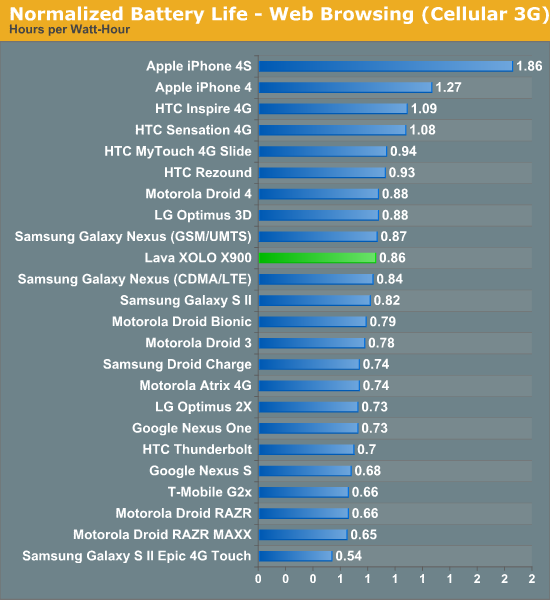
Normalizing for battery capacity, the X900 actually does a bit above average. In other words, the Medfield platform appears to be just as power efficient as some of the newer OMAP 4 based smartphones.
On WiFi the situation is no different:
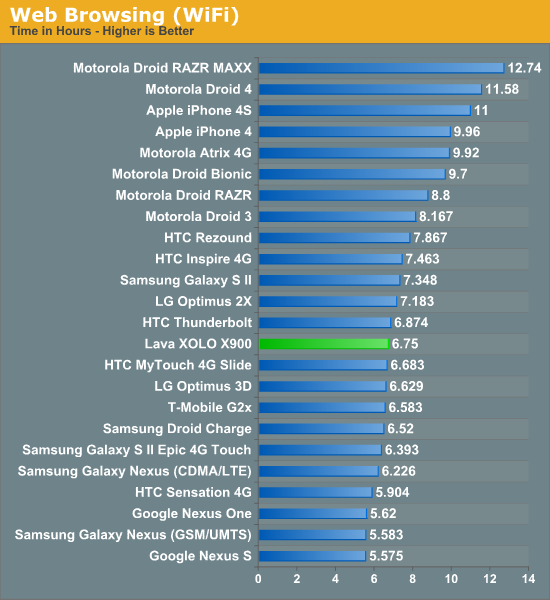
Again we see reasonable numbers for the X900 but nothing stellar. The good news is that the whole x86 can't be power efficient argument appears to be completely debunked with the release of a single device. To move up in the charts however, Intel needs to outfit its reference design with a bigger battery - something I've heard is coming with the Z2580's FFRD. The normalized results put the X900 at the middle of the pack:
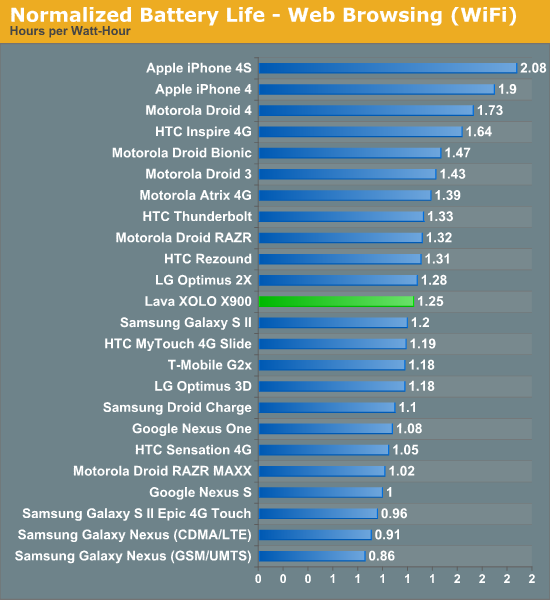
We see similar results in our talk time and 3G hotspot tests:

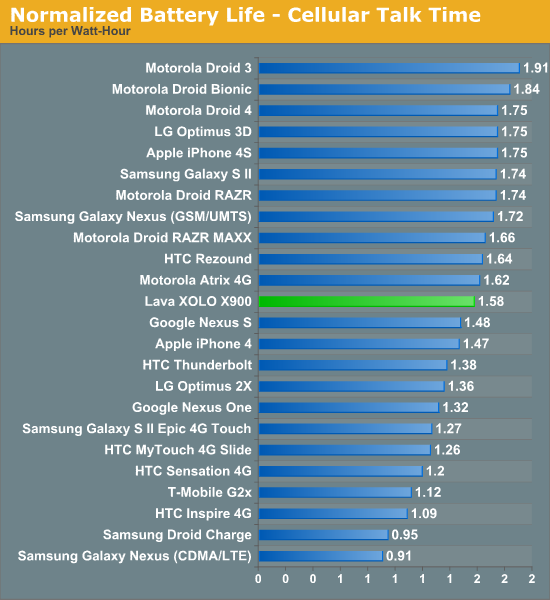
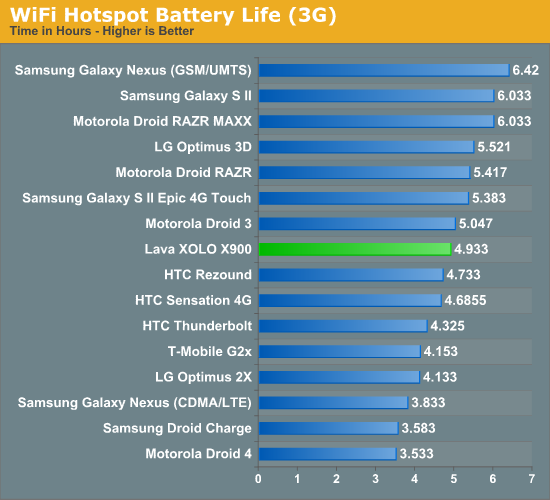
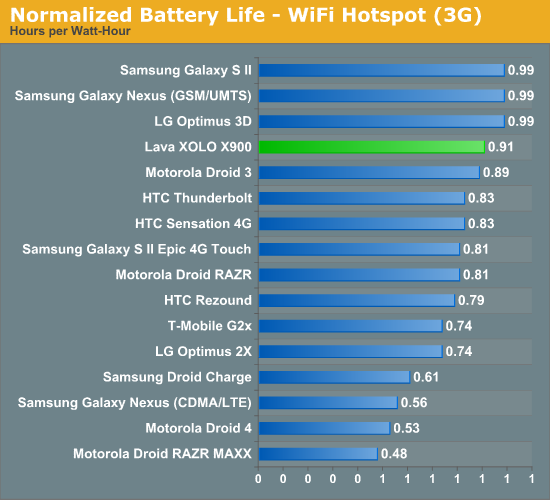










106 Comments
View All Comments
kyuu - Wednesday, April 25, 2012 - link
I dunno what review you all were reading, but I didn't see average performance. I saw it pretty much beating everything else save the HTC One S/X with only a single-core and running an old version of Android. Wth ICS, it'd probably be at the top easily.Sure, ARM isn't sitting still, but is Intel. I have no desire to see Intel overtake the market, but I can easily see Intel being the performance king by a good margin in the mobile SoC market when they release their next SoC.
Also, for people saying cost is a factor... do you have any source to back up the claim that Intel's SoC is significantly more costly? All I see are assumptions.
kyuu - Wednesday, April 25, 2012 - link
That's "neither is Intel" in the second paragraph, first sentence.UpSpin - Thursday, April 26, 2012 - link
SunSpider and Browsermark results are that good because of software tweaks done by Intel. Intel tweaked a lot in software, thus I doubt that ICS will improve anything further.Linpack single threaded, that's the most important benchmark to compare raw processing power without software tweaks. It shows that Medifield is faster than ARM A9, a good sign, but slower than Krait and thus all soon to get released A15 cores, a bad sign.
Linpack multi threaded shows that Medfield has not the slightest chance vs. Krait and ARM A15, most of them will be dual core SoCs, but even if they get produced in single core varients they will be faster (Linpack single threaded). Medifield also gets beaten by Quad Core A9 chips (all new high end smartphones pack either a Quad Core A9, or dual Core krait/A15). Medfield is at best, as fast as a dual core A9 (raw processing power).
Then take a look at the GPU: Poor performance for todays standards. Slower than the SGSII, slightly faster than the Galaxy Nexus, which has a slow GPU, too.
Power consumption: poor to average. (sadly we don't have numbers for Krait or Tegra 3 (HTC One X/S)
The SoC is not bad at all, but its release date is one year too late. This year is the year of Krait and A15, which beat Medfield in single threaded applications and are at least dual cores, so more than twice as fast. The integrated GPU is pretty weak, too, especially if you consider that this years ARM SoCs have a much better GPU.
Additionally x86, the advantage is huge software tweaks thanks to Intel, the disadvantage, custom skins/apps/features made by third party manufacturers won't run that easily.
Exophase - Friday, April 27, 2012 - link
Intel doesn't tweak Sunspider or Browsermark. But Javascript JIT performance is probably much better on x86 than ARM right now because it got a ton of attention on PCs from all major browser vendors, starting with the release of Chrome. And there's at least one major ARM improvement (EABI hardfloat) that's in V8 but didn't make it into official Android yet.Browsermark is only partially Javascript, but the other part (HTML5 rendering) is really lame too. Run it and you'll see what I mean, I hope.
Linpack is also a lousy benchmark. Any serious vector FP code on a phone (like matrix stuff for a game) would use SIMD with compiler intrinsics or ASM, and probably single precision over double precision. But even as a Dalvik double precision floating point test it sucks because it's not tiled and therefore heavily bandwidth limited.
Basically, most of the benchmarks used are awful.
clockerspiel - Wednesday, April 25, 2012 - link
The cell phone industry desparately needs a "flagship" representative for the Android ecosystem - and this ain't it!jjj - Wednesday, April 25, 2012 - link
You can't normalize battery life unless you factor in the screen size since the screen uses a lot of power and the handset's volume is directly related to the screen size and battery size.By normalizing you are making things worse than better.If you can't measure the power consumption for just the SoC you might as well just provide the system's battery life since,in the end, that's what matters anyway.
It is what it is,you can't take out the screen or the RAM or the NAND but that's no reason to make things worse with tests that distort the reality instead of helping.
menting - Wednesday, April 25, 2012 - link
uhh, it's not measuring the power consumption for the SoC, it's measuring the whole phone's power usage. So in this case, normalizing IS a valid way to go about this.plamengv - Wednesday, April 25, 2012 - link
It is beyond me why Intel will market x86 CPU with OS that has nothing to do with x86. The people who want Android will always go with the better looking and cheaper device. Something that this device is not. The other with knowledge will go for iPhone because there is no other alternative. Windows Phone is from professional point of view worse than Windows Mobile 6.5 and lacks lot of features. Intel had to bet on Windows 7 turning the smartphones into UMPC. Imagine Viliv S5 shrinked to Galaxy Note but running Windows 7! Well maybe Haswell and 22nm will finally make it.menting - Wednesday, April 25, 2012 - link
android was built from Linux..tell me where Linux has nothing to do with x86. And with future android versions including x86 compiles by default., x86 or not isn't an issue.The X900 is a reference design, who says other companies can't put a different external case on it? And where's proof that it will be more expensive?
superPC - Thursday, April 26, 2012 - link
why windows 7? windows 8 would be a lot better suited for something similar with this phone (with compatible GPU).